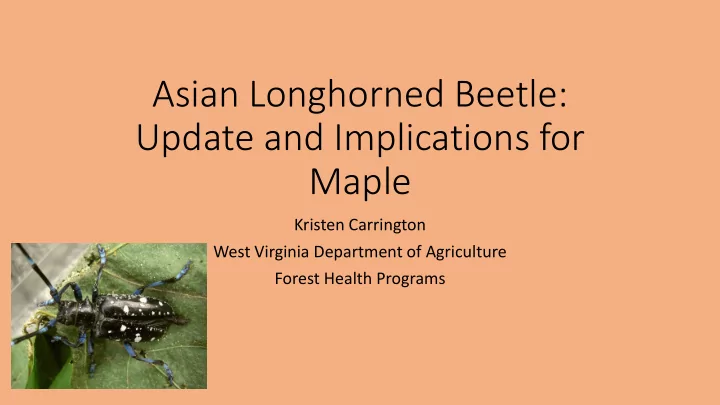

Asian Longhorned Beetle: Update and Implications for Maple Kristen Carrington West Virginia Department of Agriculture Forest Health Programs
The Asian longhorned beetle, or ALB, is an invasive insect that feeds on a wide variety of trees in the United States, eventually killing them. ALB’s preferred host is the sugar maple. The beetle is native to China and the Korean Peninsula and is in the wood-boring beetle family Cerambycidae .
It most likely came to the United States inside wood packaging material from Asia. Since its first discovery in Brooklyn, NY, in 1996, the beetle has been found in five States: New York (1996), Illinois (1998), New Jersey (2002), Massachusetts (2008), and Ohio (2011).
Residents in the ALB regulated areas established within Clermont County cannot move firewood or wood debris outside of the regulated area and outside of East Fork State Park. Residents are also discouraged from moving firewood and wood debris inside the regulated area.
The quarantine restricts the movement of hardwood logs, firewood, stumps, roots and branches out of the regulated area and also restricts the sale of nursery stock, green lumber, and logs of the following trees: maples, horse chestnut, buckeye, mimosa, birch, ash, golden raintree, katsura, sycamore, poplar, willow, mountain ash, and elms. Program staff continue to monitor regulated areas, respond to service calls and conduct training sessions for compliance agreements.
Adult Asian longhorned beetles are large (0.75 - 1.50 inches long) with very long black and white banded antennae. The body is glossy black with irregular white spots. Adults can be seen from late spring to fall depending on the climate.
Adult Male Adult Female
Females chew through the bark down to the cambium/phloem interface with the xylem, and then turn around and inject an egg (one egg per oviposition niche or site) into the tree, creating a visible oviposition scar on the surface of the tree. Eggs sites are oval or round wounds in the bark (up to 0.5 inch diameter).
The early stages of the larvae feed between the xylem and the phloem, the later stages feed only on the xylem. Mature larvae reach 2.0 inches in length.
The larvae then enter the pupal stage. The pupae are 1.25 inches long. The adults later emerge and bore their way out of the tree.
Adult emergence creates 0.5 inch circular emergence holes that can be seen all year round. The entire process, from egg to adult, lasts 12 to 18 months.
Site Location County Camp Creek Mercer Ohio River Island NWR Pleasant Holly River Webster Summersville Lake Nicholas Chief Logan Logan Bluestone SP Summers Pipestem Summers Greenbrier SF Greenbrier Tygart Lake Taylor
If you think you have found ALB, please contact Kristen Carrington at (304)558-2212 at the West Virginia Department of Agriculture.
Recommend
More recommend